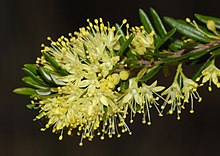Leionema phylicifolium
Leionema phylicifolium, commonly known as alpine phebalium,[2] is a shrub that is endemic to south-eastern Australia. It is a small shrub with green, smooth, leathery leaves and pale yellow flowers in spring.
| Alpine phebalium | |
|---|---|
| Scientific classification | |
| Kingdom: | Plantae |
| Clade: | Tracheophytes |
| Clade: | Angiosperms |
| Clade: | Eudicots |
| Clade: | Rosids |
| Order: | Sapindales |
| Family: | Rutaceae |
| Genus: | Leionema |
| Species: | L. phylicifolium |
| Binomial name | |
| Leionema phylicifolium | |
| Synonyms | |
| |

Description
Leionema phylicifolium is a compact shrub to 1.5 m (4 ft 11 in) high, branchlets are more or less needle-shaped with star to upright shaped soft hairs. The leathery, smooth leaves are oblong to elliptic shaped or narrow with recurved edges, 8–17 mm (0.31–0.67 in) long, 1.5–2.5 mm (0.059–0.098 in) wide and smooth margins. The inflorescence is a cluster of mostly 3-4 flowers in a cylindrical arrangement at the end of branches on a small stalk or a peduncle to 4 mm (0.16 in) long in leaf axils. The flower cluster is on a more or less fleshy, smooth pedicel 1–3 mm (0.039–0.118 in) long and has tiny egg-shaped bracts. The smooth calyx lobes are triangular shaped, 0.5 mm (0.020 in) and smooth. The petals are narrowly elliptic, spreading, 3.5–4 mm (0.14–0.16 in) long and pale yellow and stamens marginally longer than petals. The dry fruit has occasional hairs, rounded at the apex, about 3 mm (0.12 in) long and a very small beak.[3][4]
Taxonomy
The species was first formally described by Victorian Government Botanist Ferdinand von Mueller who had observed the species "on the highest peaks of the Cobboras Mountains, and on the sources of the Mitta Mitta." Mueller named it Phebalium phylicifolium and the description was published in Transactions and Proceedings of the Victorian Institute for the Advancement of Science.[5][6] In 1998 Paul G. Wilson changed the name to Leionema phylicifolium and the name change was published in the journal Nuytsia.[7][8]
Distribution and habitat
Alpine phebalium is found growing at higher altitudes in eastern Victoria in scrubland, eucalypt woodland and heath, mostly in wetter locations. It also occurs in New South Wales in the extreme south-east of the state in the Kosciuszko National Park and south from the upper Tuross River in dry sclerophyll forest and heath.[2][4][9]
References
- "Leionema phylicifolium". Australian Plant Census. Retrieved 29 June 2020.
- "Leionema phylicifolium". PlantNET-NSW flora online. Royal Botanic Gardens Sydney. Retrieved 30 June 2020.
- Wilson, Paul G. (1999). Flora of Australia-Volume 26 Meliaceae, Rutaceae, Zygophyllaceae. Canberra/Melbourne: ABRS-Department of Environment & Heritage. p. 435. ISBN 9780643109551.
- "Leionema phylicifolium". VICFLORA-Flora of Victoria online. Royal Botanic Gardens Victoria. Retrieved 30 June 2020.
- "Description of fifty new Australian plants, chiefly from the colony of Victoria". Biodiversity Heritage Library. Retrieved 30 June 2020.
- "Phebalium phylicifolium". Australian Plant Name Index. Retrieved 30 June 2020.
- "Leionema phylicifolium". Australian Plant Name Index (APNI), IBIS database. Centre for Plant Biodiversity Research, Australian Government, Canberra. Retrieved 13 March 2012.
- Wilson, Paul G. (1998). "New species and nomenclatural changes in Phebalium and related genera (Rutaceae)". Nuytsia. 12 (2): 276. Retrieved 29 June 2020.
- "Leionema phylicifolium". Flora of Australia-online. Australian Biological Resources Study, Department of Agriculture, Water and the Environment: Canberra. Retrieved 30 June 2020.
External links
- "Leionema phylicifolium (F.Muell.) Paul G.Wilson". Atlas of Living Australia.
![]()